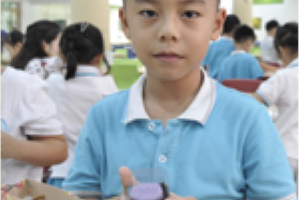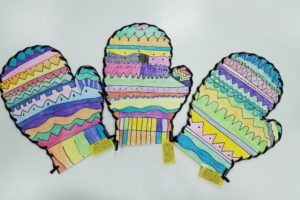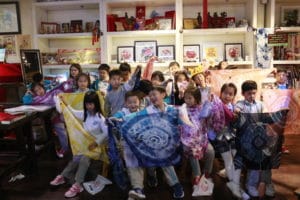
Wahaha International School is not just an extraordinary international school with a broad vision but also a school deeply rooted and nurtured in Chinese culture. Consequently, WIS has always adhered to the vision of “cultivating international ambassadors who possess a deep understanding of Chinese culture, a global perspective, and a broad-minded attitude towards embracing the world.”
Hence, our Chinese curriculum holds particular significance. Chinese is not merely a language; it’s a gateway to China’s rich history and unique culture.
Today, let’s together open the doors to explore examples of WIS’s Chinese curriculum from the past few months.
Nine Creeks in Misty Forest
A Chinese philosopher once said, “Traveling thousands of miles and reading thousands of books are equally important; practice is a crucial pathway to learning knowledge.”
G8 students from WIS and WBS engaged in a highly productive Chinese Language and Literature experiential learning activity at Jiuxi Yan Shu.
Jiuxi Yan Shu, amidst the mountains to the west of West Lake, spans from Longjing in the north to the Qiantang River in the south. Winding through layers of peaks, scattered tea gardens, meandering streams, and melodious mountain birds, it offers breathtaking views on sunny days and a mystical landscape on cloudy ones.
This event not only allowed students to immerse themselves in the natural beauty of Jiuxi Yan Shu but also equipped them with the skills needed to compose descriptive prose.
Under the guidance of their teachers, students learned essential elements of descriptive prose, such as observing details, employing adjectives, and creating vivid scenes.
In the latter part of the activity, students collaborated in small groups to produce short travel videos, using visual language to express their unique experiences at Jiuxi Yan Shu. This not only improved their teamwork and creative expression skills but also provided them with a practical opportunity to apply both linguistic and visual elements in their creative work.
During the sharing and reflection session, students deepened their understanding of their work through mutual exchange and feedback from their Chinese language teachers. This experience has laid a solid foundation for their future learning and creative endeavors.
Imagining Boundless World,
Writing Our Fairytales
Every visitor stepping into the G3 classroom at WIS will be captivated by the vibrant and diverse display boards along the walls.
Among the first to catch your eye are the fairytales crafted by the students themselves.
Each tale, such as “Mr. Carrot with a Long Beard”, strikes a balance between seriousness and playfulness, showcasing the imaginative flights of the students’ minds.
While “Mr. Carrot with a Long Beard” originates from the compiled textbook, serving the purpose of guiding students to predict story endings, in our unit, we used this text as a starting point for students to apply the unique structure of fairytales learned into their own storytelling.
However, in our unit, we use this passage as an introduction, encouraging students to apply the special structure of the fairytales they’ve learned, specifically “repetition“ to their story writing.
Each child added a paragraph, linking them together to form a complete story. This approach to writing lowered the barriers of length and difficulty, aiding third-grade students in overcoming hurdles related to “difficulty in writing” and “not being able to write long pieces.”
The students’ minds are imaginative; “Mr. Carrot’s beard” is undergoing magical adventures in their writing.
Finally, we introduced the use of voice recording boxes to add an element of fun to this writing activity. Additionally, through the “reading aloud recordings”, we indirectly guided students to review and reflect on their writing after completion.
Furthermore, the display boards showcased the creation of traditional incense sticks during Chinese cultural classes, allowing one to experience the fragrance before seeing it.
Although seemingly simple, the idea stemmed from poems about the four seasons in “Chinese Classical Pocket Books” for the third graders.
Lastly, a section dedicated to children’s philosophy comprised fascinating question-and-answer discussions from class.
Teachers, based on the students’ interests, selected engaging sections from the texts and facilitated discussions, such as understanding concepts of fairness, individuality, and collectivism.
The most remarkable answers from the students were recorded on these display boards.
In fact, Chinese elements are visible everywhere on the WIS campus. Apart from the themed display boards in the G3 area, just wandering around the campus allows us to gain a wealth of Chinese knowledge.
Another Harvest Season for the Debate Team
In October, the WIS Chinese Debate Society sent out three teams to participate in the 2023 Autumn Zongheng Cup Chinese Debate Competition. In this competition, there were not only skilled veteran debaters but also our inexperienced new members.
Despite the very limited preparation time, the students diligently prepared, exchanged ideas, and under the guidance of four Chinese teachers, they ultimately achieved an impressive third place finish.
Another great piece of news worth sharing: in November, we selected eight debaters from the debate team to represent WIS in an exchange competition at Hangzhou BASIS International School. Our debaters displayed fluency, confidence, and agility in their debating skills, language proficiency, and in-depth thinking and logical reasoning on the debate topics.
Through this competition, both teachers and students from both sides established friendly relations, opening a door for future exchanges and mutual learning.
On January 12th, the WIS Chinese Debate Club will be hosting a showcase for all students at the school. We hope that through this event, more students will understand what debate is about and the captivating allure that drives our members to strive relentlessly.
Additionally, our debate club is recruiting new members. If you’re interested, come join us!
Creating Our Own Poetry and Songs
In an interdisciplinary unit (IDU), G7 students showcased the seamless integration of Chinese and music courses.
In this unique IDU experience, students delve into the intricate connections between Music and Chinese poetry. In their Chinese class, students ingeniously craft their own poems in groups, and concurrently. In their Music class, they dedicate themselves to the intricate task of transforming these poems into traditional Chinese-style musical compositions.
This collaborative effort not only allows our students to appreciate the aesthetic charm of classical Chinese language and music but also enables them to deepen their understanding of the inherent cultural and artistic dimensions in both disciplines.
We believe that the WIS Chinese Course will become the key for every WIS student to unlock the beauty and richness of Chinese culture. Through this innovative course, our students will have the opportunity to explore and appreciate the depths of Chinese traditional culture, cultivate cultural confidence, and ultimately become cultural ambassadors who can share the beauty of Chinese culture with the world.





